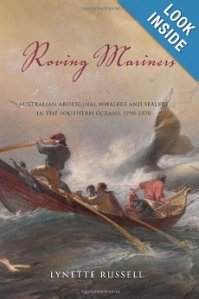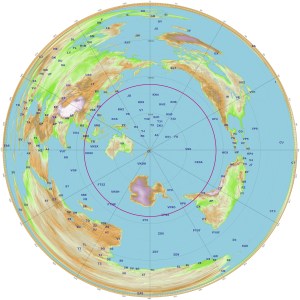Roving Mariners: Australian Aboriginal Whalers and Sealers in the Southern Ocean 1790-1870
2012, 140 p & notes
There are two decenterings that this book demands of its readers. The first is encapsulated by a map that looks something like this:
It’s a map showing the great circle route of the southern ocean. Dotted around and radiating out from the centre of the circle are the islands of the southern ocean: the larger land masses of Antarctica, Australia, New Zealand, and although you can’t see it here, Macquarie Island, Pitcairn Island,, Kerguelen, Chatham Island, Tahiti, Society Islands, Solomon Islands, Falkland Islands, South Georgia. It’s a view that challenges our land-mass bias by emphasizing the ocean and the space, and the relative proximity of small islands flung into the centre of the Indian, Pacific and Atlantic Oceans.
The second decentering reflects the focus on whaling and sealing in this book right up to 1870. We’re often told that whaling and sealing were primitive, increasingly marginal endeavours which were eclipsed by the pastoral industry and then the gold rushes that super-charged the Australian economy in the 1830s, 40s and 50s. It’s odd: I’ve been reading through 1840s newspapers for years now seeing mainly sheep, sheep, sheep but after reading this book suddenly I saw references to whaling all over the place- not long articles mind you, but the steady ongoing enumeration of whaling ships in the shipping news and, I must admit, the frequent presence of whalers and sealers in the criminal news.
Lynette Russell is the director of the Monash Indigneous centre at Monash University, and is herself of Tasmanian Aboriginal descent. Her own personal engagement with the history of whaling and sealing was prompted by a discussion she had with an elderly distant cousin who, like her, acknowledged descent from both Aboriginal and European ancestors. He explained that his great-great-grandparents had been sealers, she a Tasmanian Aboriginal woman and he a British seaman. When she sympathized with the virtual slavery in which Tasmanian Aboriginal women were kept, he pulled her up. They were both sealers, he said, rather than a sealer and his ‘woman’ (p. 22). This set her off to explore in a more nuanced way the complexity of the Southern Australian sealing industry.
In regard to her own Aboriginal identity, Russell embraces notions of undecidability and uncertainty:
As such, I emphatically state that I am neither one thing nor another. Though I recognize that for many (perhaps most) people the desire to acknowledge one identity over all others is paramount. For me, the binaries of Indigenous- non-Indigenous or native-newcomer- binaries that, despite their obvious artificiality, continue to be widely used- are meaningless; such simplifications hamper our understanding of the past. (p. 21)
This personal stance is reflected in the history that she writes in this book.
One of my key desires is to create a more complex and less linear narrative than has been previously produced for southern Australia. One of the complexities I wish to develop concerns the question of the boundaries surrounding who was categorized as native, who was not, and who was described as newcomer…. I believe that these categories were not stable, and during the sealing and whaling period they were perhaps in a greater state of flux than they were either before or afterward. (p. 13)
The whaling and sealing industries of the Southern Oceans were always ethnically diverse with a strong representation of ‘coloured seamen’: African and Native Americans, Native Canadians, Pacific Islanders, Maori and Aborigines. Her sources are the archival records of the maritime industry including logs, ships’ records, diaries, journals, visual materials including photographs and European artifacts. After trawling through the sources, she concluded that there was ultimately a paucity of information about the ‘coloured seamen’ that she wished to write about. This, she says, enabled space for her to imagine their lives and labours and to be “intentionally creative” (p. 16). She plunged herself into the experience of whaling and sealing: standing on the deck of a ship in the midst of a pod of sperm wales; standing on Kangaroo Island amongst a colony of noisy, smelly fur seals.
I must admit that there is much in her upfront description of her political stance and methodology that discomfits me (and I should imagine that within Indigenous politics, some would be even more uncomfortable), but I found little in the text itself that unsettled me. Instead, I sensed that she had read widely and imaginatively and that there was a strong tethering in verifiable, if diverse, sources (with one major exception where I felt that her creative imagination was straining the evidence too much). She is very much present in the text. Her argument is strenuous and well argued, and it has the effect of challenging easy assumptions.
She focusses in particular on two men: Tommy Chaseland, and William Lanne. Thomas Chaseland was born illegitimately to an Aboriginal woman and a white emancipist father. He was sent to work in the shipping yards of the Hawkesbury River and signed on to the Jupiter. After a succession of stints on various whaling ships, he settled in New Zealand where he became the husband of a high-ranking Maori woman and made his home on the isolated Codfish and Stewart Islands before moving to the Fiordlands west of Stewart Island where he and his wife worked on a whaling station.
William Lanne, often incorrectly described as ‘the last Tasmanian Aboriginal male’ is more widely known, largely in terms of the outrageously disrespectful treatment of his body after his death. Russell examines Lanne as one of three Tasmanian Aboriginal men who pursued their luck at sea alongside Captain Henry Whalley and Walter George Arthur. The details of what happened after his death almost obscure the life that he lived, but Russell attempts to reconstruct it.
Reconstruction of a life becomes even more difficult when she turns her attention to Tasmanian Aboriginal women. Here she follows two other historians, Rebe Taylor who examined Kangaroo Island and Lyndall Ryan who focussed on Bass Strait and Tasmania. She acknowledges her debt to this work, and tries to take it further by endeavouring to bring the wives and women from the shadows of the narrative. It is a difficult task that involves reading against the sources, many of which were written by the missionaries who tried unsuccessfully to get the women to leave the islands. She is extremely careful in her discussion of freedom, action and choices and her caution in the text behooves us to read closely and to attend to her hesitations and qualifications.
This is a beautifully written and nuanced reflective history. It is at the same time easy to read and yet requires much of the reader as well in terms of weighing the argument and her use of sources.
A review of the book is available on H-Net.
 I am posting this review to the Australian Women Writer’s Challenge under the History/Biography/Memoir section.
I am posting this review to the Australian Women Writer’s Challenge under the History/Biography/Memoir section.



I will have a look at this book in more detail – and it’s a terrific story, which deserves to be better known. But I confess I was startled to see the cover – because it is the EXACT same image that I have on the cover of my book, Ben Boyd of Boyd Town (1995 edition), even to the title font. See here – learnearnandreturn.wordpress.com/my-books
The painting ‘Whalers at Twofold bay’ is in the NSW Art Gallery, and it is by Oswald Brierly, artist and whaling station manager for Boyd in the 1840s. Brierly’s diaries are in Mitchell, and on microfilm – and a detailed source of information about Aboriginal whalers.
Do you know, I pulled down your book from my shelf today when I was writing this post- not the book you mentioned but ‘The Seahorse and the Wanderer’ (an earlier edition?). I thought of you and wondered if you’d read it. You’ll probably have a MUCH MUCH more informed view of the book than I did.
I bet you did get a surprise when you saw the cover!
Yes, The Seahorse and the Wanderer was the earlier name. I’ve started reading Russell’s book now, so that you for bringing it to my attention. I always love your book reviews, Janine, you have an incredibly perceptive style.
Why, thank you Marion.
Thank you, not that you!
Pingback: From Cover to Cover | Historians are Past Caring
Pingback: Histories, Biographies, Memoirs – Roundup #9 2013 | Australian Women Writers Challenge
Pingback: Sept – Nov 2013 Roundup: Diversity | Australian Women Writers Challenge
Pingback: Australian Women Writers Challenge 2013 completed! | The Resident Judge of Port Phillip
Pingback: 2013 AWW Challenge Wrap-up: Diversity | Australian Women Writers Challenge
Pingback: Looking back at a historian looking forward | The Resident Judge of Port Phillip
Pingback: Six degrees of separation: From ‘Eats Shoots and Leaves’ to….. | The Resident Judge of Port Phillip